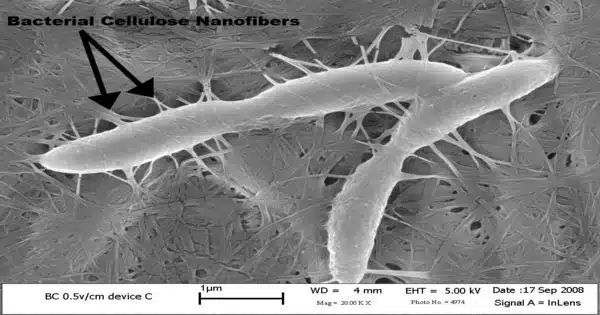Bacterial cellulose is a type of cellulose produced by certain bacteria. Certain bacteria create an organic molecule with the formula (C6H10O5)n. Unlike plant cellulose, which is often found in plant cell walls, bacterial cellulose is created by bacteria during the fermentation process. While cellulose is a fundamental structural component of most plants, it is also produced by bacteria, primarily from the genera Komagataeibacter, Acetobacter, Sarcina ventriculi, and Agrobacterium.
Bacterial or microbial cellulose differs from plant cellulose in that it is purer, stronger, more moldable, and has a higher water holding capacity. Acetobacter, Gluconacetobacter, and Sarcina are the most common genera linked with bacterial cellulose synthesis.
In their natural environment, the majority of bacteria produce extracellular polysaccharides such as cellulose, which create protective envelopes around the cells. While bacterial cellulose is naturally produced, several strategies are now being researched to increase cellulose development from laboratory cultures on a big scale.
Here are some key points about bacterial cellulose:
- Production: Bacterial cellulose is produced by bacteria as they synthesize cellulose fibrils. The bacteria ferment glucose or other sugars to produce cellulose as an extracellular matrix.
- Structure: The structure of bacterial cellulose is similar to plant cellulose, consisting of long chains of glucose molecules. However, the arrangement of these chains and the resulting material properties can differ.
- Properties: Bacterial cellulose has unique properties that make it valuable for various applications. It has high purity, high crystallinity, and excellent mechanical strength. Additionally, it has a high water-holding capacity and is often used in applications where absorbency is important.
By controlling synthesis methods, the resulting microbial cellulose can be tailored to have specific desirable properties. For example, attention has been given to the bacteria Komagataeibacter xylinus due to its cellulose’s unique mechanical properties and applications to biotechnology, microbiology, and materials science.
Applications:
- Biomedical: Bacterial cellulose is used in medical and biomedical applications, such as wound dressings and skin substitutes, due to its biocompatibility and ability to retain moisture.
- Food Industry: It is used in the food industry for gelling agents and as a stabilizer in some food products.
- Textiles: Bacterial cellulose can be used to produce textiles with unique properties, including breathability and comfort.
- Paper and Packaging: It has been explored for use in paper and packaging materials.
- Biotechnology: Bacterial cellulose manufacturing is also gaining attention in biotechnology due to its potential as a sustainable and renewable biomaterial.
Bacterial cellulose has been studied for its possible use in the restoration and preservation of cultural heritage artifacts because of its stability and non-destructive qualities. Bacterial cellulose synthesis is frequently thought to be more environmentally friendly than traditional cellulose sources such as wood pulp since it may use a variety of waste materials as a carbon source.















